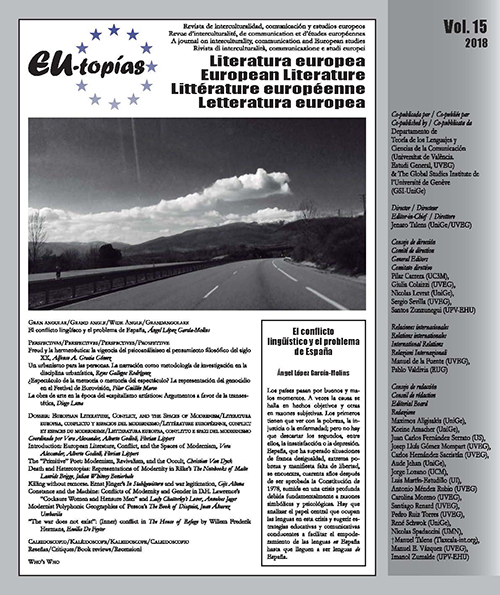Constance and the Machine: Conflicts of Modernity and Gender in D.H. Lawrence’s “Cocksure Women and Hensure Men” and Lady Chatterley’s Lover
DOI:
https://doi.org/10.7203/eutopias.0.18580Keywords:
D.H. Lawrence, gender, masculinity Abstract
Abstract
Lawrence’s “Cocksure Women and Hensure Men” and Lady Chatterley’s Lover both base their argument around gender essentialism. Lady Chatterley’s Lover and the debate surrounding the trial that led to its uncensored publication are rooted in a combination of sexual, gender, and class politics. Moreover, while Lady Chatterley’s Lover may look like a critique of individuality and industrialization, it is actually a critique of a hegemonic masculinity based on rationality. This paper will argue that one of the central conflicts of the novel is that surrounding early-twentieth-century hegemonic masculinity, by means of R.W. Connell’s theory. Through unravelling the complex gender politics in Lawrence’s work and placing them in their historical context, this paper argues that his work is more reactionary than subversive.
 Downloads
Downloads
 References
References
Bedient, Calvin (1966), “The Radicalism of ‘Lady Chatterley’s Lover’”, The Hudson Review, 19, 3, pp. 407-16.
Black, Michael H. (2017), “D.H. Lawrence”, Encyclopedia Britannica, Britannica.com.
Connell, R. W. (2005), Masculinities, Berkeley: University of California Press.
Connell, R. W. (1987), Gender and Power, Cambridge: Polity Press.
Francis, Martin (2002), “The Domestication of the Male? Recent Research on Nineteenth-and Twentieth- Century British Masculinity”, The Historical Journal, 45, 3, pp. 637-652.
Gubar, Susan, and Sandra Gilbert (1979), The Madwoman in the Attic, New Haven: Yale UP.
Kimmel, Michael S. & Aronson, Amy (2003), Men and Masculinities: A Social, Cultural, and Historical Encyclopedia, Santa Barbara: ABC-CLIO.
Lawrence, D. H. (1954), Selected Essays, London: Penguin.
Lawrence, D. H. (1961), Lady Chatterley’s Lover, London: Penguin.
Lusty, Natalya, & Murphet, Julian (ed.) (2014), Modernism and Masculinity. Cambridge: Cambridge University Press.
Marinetti, Filippo, (2017) [1909], “The Futurist Manifesto”, BBC news, bbcnews.com.
Millett, Kate (1970), Sexual Politics, London: Virago.
Raub, Patricia (1994), “A New Woman or an Old-Fashioned Girl? The Portrayal of the Heroine in Popular Women’s Novels of the Twenties”, American Studies, 35, 1, pp. 109-130.
Rolph, C.H. (ed.) (1961), The Trial of Lady Chatterley, London: Penguin.
Simmel, Georg & Wolff, Kurt (1950), The Sociology of Georg Simmel, Glenco: Free Press.
“smart, adj.” (2017), OED Online, Oxford University Press.
Worthen, John (2005), DH Lawrence: The Life of an Outsider, Counterpoint Press.
Downloads
Published
How to Cite
-
Abstract179
-
PDF67
Issue
Section
License
![]()
The authors conserve the copyright. All content published in EU-topías. Journal of interculturality, Communication, and European Studies are subject to the license Creative Commons Attribution-NonCommercial-ShareAlike 4.0 license. The full text of the license can be found at <http://creativecommons.org/licenses/by-nc-sa/4.0>
They may be copied, used, disseminated, transmitted and publicly displayed, provided that:
- The authorship and original source of the publication is cited (journal, publisher and URL of the work).
- They are not used for commercial purposes.
- The existence and specifications of this license of use are mentioned.
It is the responsibility of the authors to obtain the necessary permissions for images that are subject to copyright.



